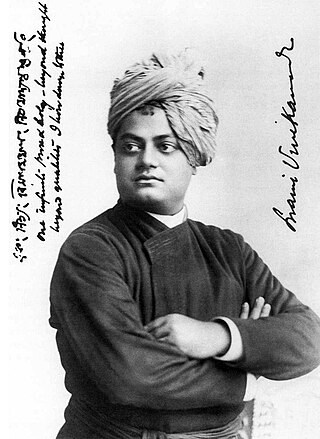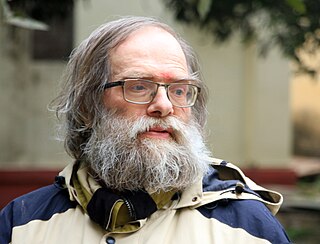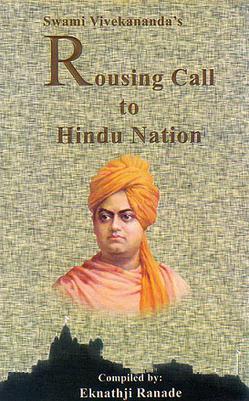
Swami Vivekananda, born Narendranath Datta, was an Indian Hindu monk, philosopher, author, religious teacher, and the chief disciple of the Indian mystic Ramakrishna. He was a key figure in the introduction of Vedanta and Yoga to the Western world, and the father of modern Indian nationalism who is credited with raising interfaith awareness and bringing Hinduism to the status of a major world religion.

Rashtriya Swayamsevak Sangh is an Indian right-wing, Hindu nationalist volunteer paramilitary organisation. It is the progenitor and leader of a large body of organisations called the Sangh Parivar, which has developed a presence in all facets of Indian society and includes the Bharatiya Janata Party, the ruling political party under Narendra Modi, the 14th prime minister of India. Mohan Bhagwat has served as the Sarsanghchalak of the RSS since March 2009.
Hindutva is a political ideology encompassing the cultural justification of Hindu nationalism and the belief in establishing Hindu hegemony within India. The political ideology was formulated by Vinayak Damodar Savarkar in 1922. It is used by the Rashtriya Swayamsevak Sangh (RSS), the Vishva Hindu Parishad (VHP), the Bharatiya Janata Party (BJP) and other organisations, collectively called the Sangh Parivar.

David Frawley, also known as Vamadeva Shastri is an American writer, astrologer, teacher (acharya) and a proponent of Hindutva.

Koenraad Elst is a Flemish author, known primarily for his adherence to the Hindutva ideology and support of the Out of India theory, which is universally regarded as pseudo-historical by mainstream scholarship. Scholars accuse him of harboring Islamophobia.
The Sangh Parivar refers, as an umbrella term, to the collection of Hindutva organisations spawned by the Rashtriya Swayamsevak Sangh (RSS), which remain affiliated to it. These include the political party Bharatiya Janata Party, religious organisation Vishva Hindu Parishad, students union Akhil Bharatiya Vidyarthi Parishad (ABVP), religious militant organisation Bajrang Dal that forms the youth wing of the Vishva Hindu Parishad (VHP), and the worker's union Bharatiya Kisan Sangh. It is also often taken to include allied organisations such as the Shiv Sena, which share the ideology of the RSS.

Ramakrishna Math and Ramakrishna Mission (RKM) is a Hindu religious, spiritual and philanthropic organisation headquartered in Belur Math, West Bengal. The mission is named after the Indian Hindu spiritual guru and mystic Ramakrishna. The mission was founded by Ramakrishna's chief disciple Swami Vivekananda on 1 May 1897. The organisation mainly propagates the Hindu philosophy of Vedanta–Advaita Vedanta and four yogic ideals – Jnana, Bhakti, Karma, and Raja yoga. The mission bases its work on the principles of Karma Yoga, the principle of selfless work done with a dedication to God.

The Hindu American Foundation is an American Hindu non-profit advocacy group founded in 2003. The organisation has its roots in the Hindu nationalist organisation Vishwa Hindu Parishad America and its student wing Hindu Students Council.

Swami Rama Tirtha, also known as Ram Soami, was an Indian teacher of the Hindu philosophy of Vedanta. He was among the first notable teachers of Hinduism to lecture in the United States, travelling there in 1902, preceded by Swami Vivekananda in 1893 and followed by Paramahansa Yogananda in 1920. During his American tours Swami Rama Tirtha spoke frequently on the concept of 'practical Vedanta' and education of Indian youth. He proposed bringing young Indians to American universities and helped establish scholarships for Indian students.
The National Hindu Students' Forum (NHSF (UK)) is a network of Hindu societies operating on university and further education campuses in the United Kingdom. The NHSF (UK) was started in 1991 from a stall at a Hindu marathon, but now operates in around 50 different institutions around the United Kingdom. The NHSF has been described by historian Edward Anderson as having ties to the Sangh Parivar, a group of Hindu nationalist organisations in India such as the RSS and the BJP. In early years the NHSF had the same address as the HSS, a UK charity, per Manoj Ladwa, the then HSS spokesman. Ladwa later served as a senior advisor to Narendra Modi during his successful Indian election campaign of 2014. Although the HSS is considered to be inspired by the RSS, a UK charity commission inquiry in 2016 found no formal links between the two.
Voice of India (VOI) is a publishing house based in New Delhi, India, that specialises in Hindu nationalist books and serves as one of the most important tools in the development of Hindutva ideologies.

The Rashtra Sevika Samiti is a Hindu nationalist women's organisation that parallels the Rashtriya Swayamsevak Sangh (RSS) for men. Even though it is often referred to as the "Sister" of the RSS, the organisation claims that it is independent of the RSS while sharing its ideology. Membership and leadership is embraced to women and its activities are directed to nationalist devotion and mobilisation of Hindu women.

Sadhvi Rithambara is a Hindu nun (sadhvi), public speaker and nationalist ideologue who is the founder-chairperson of Durga Vahini, the women's wing of the Vishva Hindu Parishad (VHP), established in 1991. She gained national prominence with VHP in the late 1980s through the Jan Jagran Abhiyan, and in 1990s during the run up to the Babri Masjid demolition. Subsequently, she was named an accused in the Liberhan Commission report, though later acquitted by the CBI court in 2020.
Hindu Revolution is a term in Hindu nationalism referring to a sociopolitical movement aiming to overthrow untouchability and casteism to unified social and political community to create the foundations of a modern nation.

Vishva Hindu Parishad (VHP) is an Indian right-wing Hindu organisation based on Hindu nationalism. The VHP was founded in 1964 by M. S. Golwalkar and S. S. Apte in collaboration with Swami Chinmayananda. Its stated objective is "to organise, consolidate the Hindu society and to serve and protect the Hindu Dharma". It was established to construct and renovate Hindu temples, and deal with matters of cow slaughter and religious conversion. The VHP is a member of the Sangh Parivar group, the family of Hindu nationalist organisations led by the RSS.
Hindu nationalism has been collectively referred to as the expression of social and political thought, based on the native spiritual and cultural traditions of the Indian subcontinent. "Hindu nationalism" is a simplistic translation of हिन्दू राष्ट्रवाद. It is better described as "Hindu polity".

Neo-Vedanta, also called Hindu modernism, neo-Hinduism, Global Hinduism and Hindu Universalism, are terms to characterize interpretations of Hinduism that developed in the 19th century. The term "Neo-Vedanta" was coined by German Indologist Paul Hacker, in a pejorative way, to distinguish modern developments from "traditional" Advaita Vedanta.

Rousing Call to Hindu Nation or Swami Vivekananda's Rousing Call to Hindu Nation (1963) is a compilation of Indian Hindu monk Swami Vivekananda's writings and speeches edited by Eknath Ranade the leader of Rashtriya Swayamsevak Sangh. The book was published in 1963, in the birth centenary of Vivekananda. Ranade dedicated the book as a "personal homage to the great patriot-saint" Swami Vivekananda.
Modern yoga is a wide range of yoga practices with differing purposes, encompassing in its various forms yoga philosophy derived from the Vedas, physical postures derived from Hatha yoga, devotional and tantra-based practices, and Hindu nation-building approaches.
Joseph S. Alter is an American medical anthropologist known for his research into the modern practice of yoga as exercise, his 2004 book Yoga in Modern India, and the physical and medical culture of South Asia.














